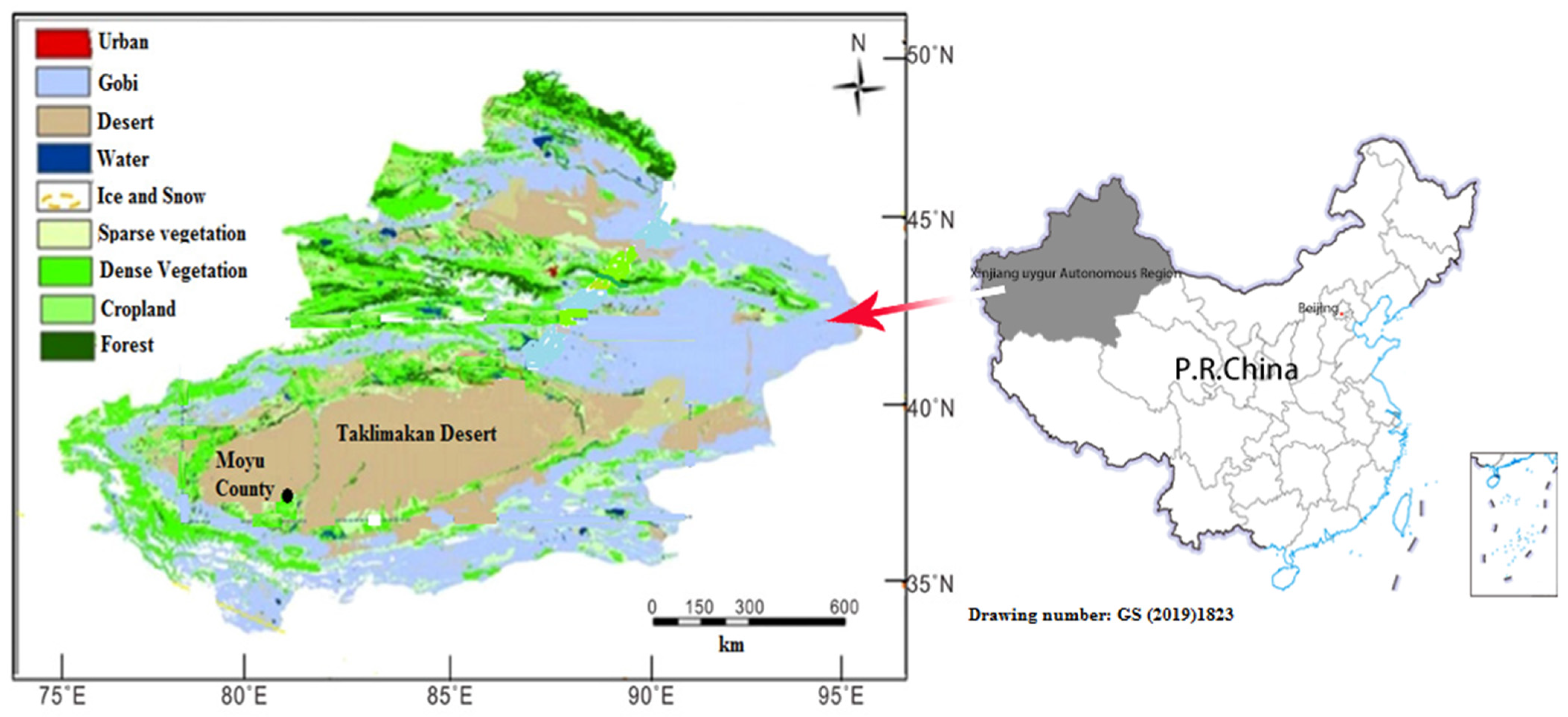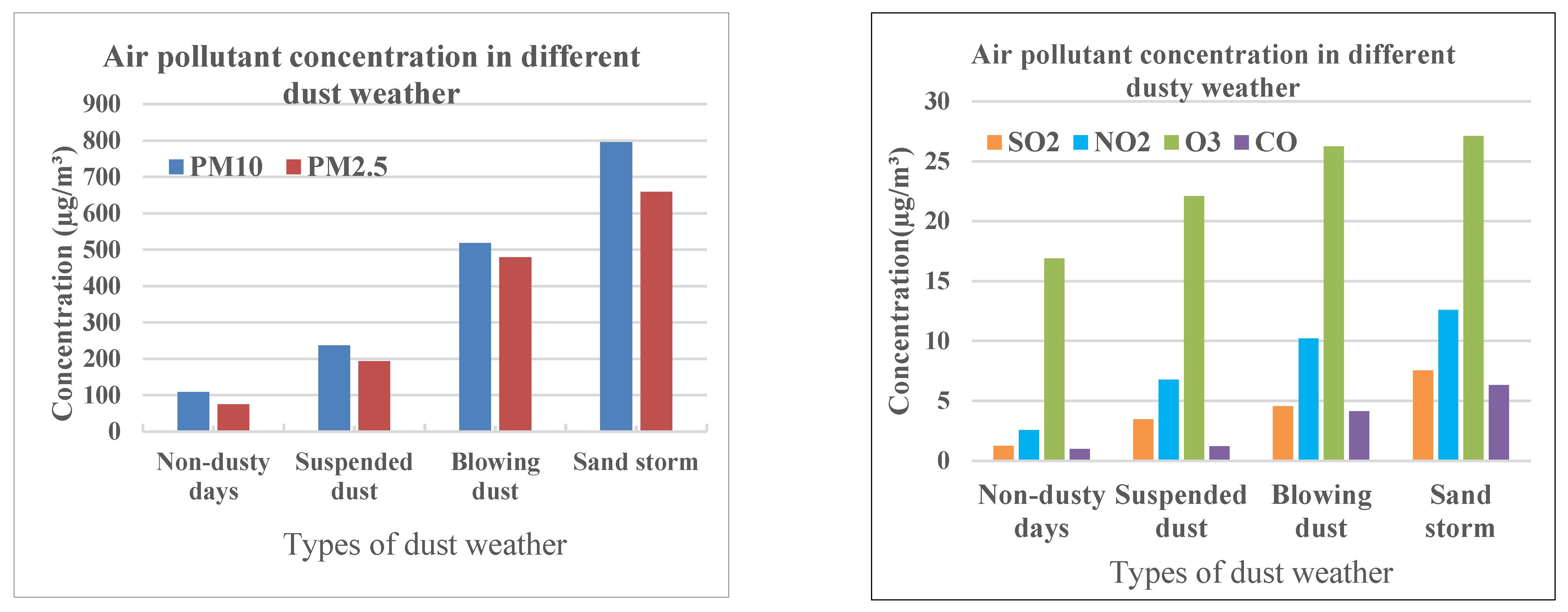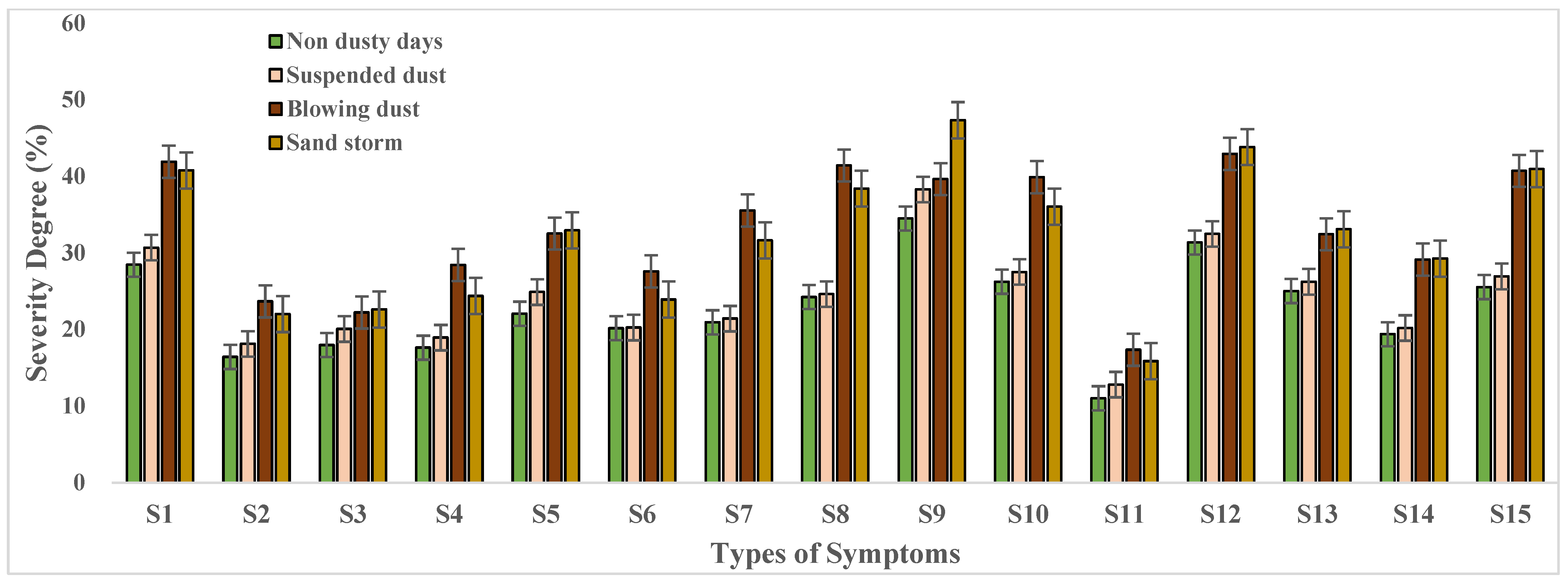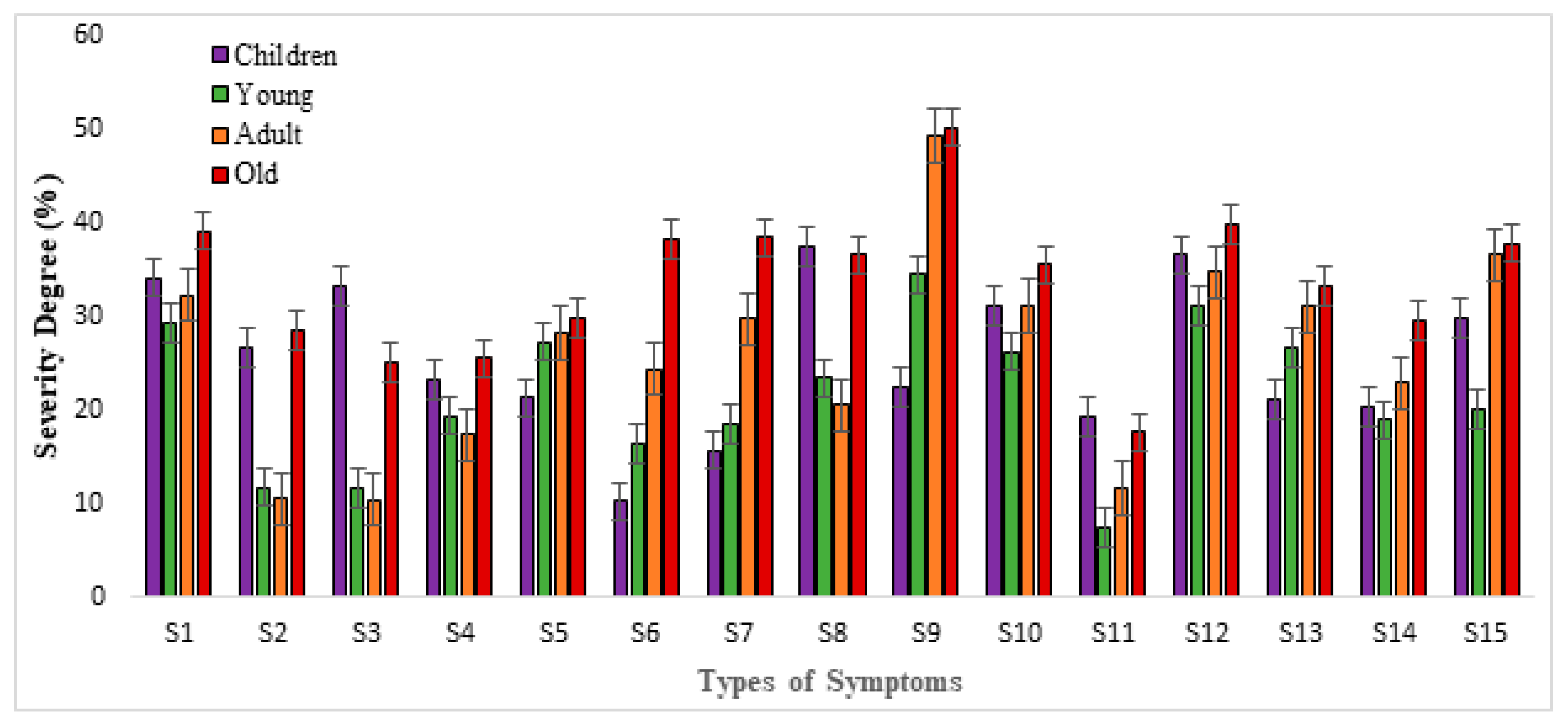Health Effects of Dust Storms on the South Edge of the Taklimakan Desert, China: A Survey-Based Approach
Abstract
:1. Introduction
2. Materials and Methods
2.1. Description of the Study Area
2.2. Material Sources
2.2.1. Step 1: Base Sample-Size Calculation
2.2.2. Step 2: Design Effect
2.2.3. Step 3: Contingency
2.2.4. Step 4: Distribution of Observations
2.3. Statistical Analysis
3. Results and Discussion
3.1. Daily Average Concentration of Air Pollutants in Different Dust Weather
3.2. Health Symptoms in Different Dust Weather Conditions
3.3. Multivariate Relationship between Air Pollutants, Meteorological Factors, and Health Symptoms
4. Conclusions
- Both dust storm frequency and intensity reached their highest values in May and the daily average concentrations of PM10 and PM2.5 increased with dust storm intensity, but high levels of SO2, NO2, O3, and CO concentrations may not be caused by dust storm weather.
- Dust weather has significant impacts on public health, no matter the age group. The influence of dust weather on different age groups shows that people in the age group above 60 years and below 15 years were more sensitive to dusty weather than people in the age groups between 15 and 60.
- The results of the PCA further confirmed the relationships between dust storm intensity, air pollutants, meteorological factors, and health symptoms. Higher concentrations of PM10 and PM2.5s, which were caused by dust storms, were significantly correlated with upper respiratory system diseases and ENT diseases such as “dry throat with bitter taste”, “itchy throat”, “hoarseness”, “dry eyes”, and “stuffy nose”. Some of the symptoms, such as “tears”, “runny nose”, “cough”, and “expectoration”, may not be caused by dust weather, but were likely related to the low temperature and higher concentrations of toxic air pollutants (SO2, NO2, CO, and O3). Further research needs to be conducted, combined with laboratorial analysis.
Author Contributions
Funding
Institutional Review Board Statement
Informed Consent Statement
Data Availability Statement
Acknowledgments
Conflicts of Interest
Abbreviation
| Abbreviation | Full Name |
| PCA | Principal component analysis |
| ANOVA | Analysis of variance |
| XUAR | Xinjiang Uygur Autonomous Region |
| AQSIQ | Administration of Quality Supervision, Inspection and Quarantine |
| NSC | National Standards Committee |
| API | Air pollution indexes |
| SPSS | Statistical Package of Social Science |
| GAM | Generalized additive model |
References
- Wang, X.M.; Dong, Z.B.; Zhang, J.W.; Liu, L.C. Modern dust storms in China: An overview. J. Arid. Environ. 2004, 58, 559–574. [Google Scholar] [CrossRef]
- Quan, L.; Shi, S.; Zhu, Y.; Qian, W. Temporal—Spatial distribution characteristics and causes of dust-day in China. Acta Geogr. Sin. 2001, 56, 477–485. (In Chinese) [Google Scholar]
- Qian, W.H.; Quan, L.S.; Shi, S.Y. Variations of the Dust Storm in China and its Climatic Control. J. Clim. 2002, 15, 76–80. [Google Scholar] [CrossRef]
- Ma, M.J.; Yang, X.H.; Yang, Q.H.; Cheng, L.Z.; Ali, M.; Wen, H.; Fan, Y. Characteristics of dust devil and its dust emission in northern margin of the Taklimakan Desert. Aeolian Res. 2020, 44, 100579. [Google Scholar] [CrossRef]
- Liu, L.Y.; Shi, P.J.; Gao, S.Y.; Zou, X.Y.; Erdon, H.; Yan, P.; Zhang, C.L. Dustfall in China’s western loess plateau as influenced by dust storm and haze events. Atmos. Environ. 2004, 38, 1699–1703. [Google Scholar] [CrossRef]
- Tian, L.; Yang, C.; Zhou, Z.J.; Wu, Z.T.; Pan, X.T.; Archie, C.A. Spatial patterns and effects of air pollution and meteorological factors on hospitalization for chronic lung diseases in Beijing, China. Sci. China Life Sci. 2019, 62, 1381–1388. [Google Scholar] [CrossRef]
- Zhang, J.Y.; Meng, H.Y.; Zhang, G.B. Relationship between air pollution and daily respiratory system disease mortality in Chaoyang district, Beijing: A time-series analysis. J. Environ. Health 2011, 28, 788–791. [Google Scholar]
- Huang, X.; Wang, G.M. Analysis of respiratory diseases and sand-dust weather in Lanzhou city. Gansu Meteorol. 2001, 19, 41–43. (In Chinese) [Google Scholar]
- Geng, H. Effects of Dust Storm on human health and in vitro responses of Rat Avleolar macrophages to dust storm PM2.5. Ph.D. Dissertation, Shanxi University, Shanxi, China, 2006. [Google Scholar]
- Meng, Z.Q.; Zhang, J.; Geng, H. The influence of dust storms on daily respiratory and circulatory outpatient number. China Environ. Sci. 2007, 27, 116–120. (In Chinese) [Google Scholar]
- Ekstrom, M.H.; Tanish, G.; Cappell, A. Australian Dust Storms: Temporal trends and relationships with synoptic pressure distributions (1960–1999). Int. J. Climatol. 2004, 24, 1581–1599. [Google Scholar] [CrossRef]
- Englert, N. Fine particles and human health—A review of epidemiological studies. Toxicol. Lett. 2004, 149, 235–242. [Google Scholar] [CrossRef]
- Jimenez, E.; Linares, C.; Roriguez, L.F.; Bleda, M.J.; Diaz, J. Short—Term impact of particulate matter(PM2.5) on daily mortality among the over-75 age group in Madrid (Spain). Sci. Total Environ. 2009, 407, 5486–5492. [Google Scholar] [CrossRef]
- Wang, S.G.; Yaun, W.; Shang, K.Z. The impact of different kinds of dust weather on PM10 pollution in northern China. Atmos. Environ. 2006, 40, 7975–7982. [Google Scholar] [CrossRef]
- Zhang, B.L.; Niu, J.P.; Cao, J.; Ruan, Y.; Zhao, N.J.; Dong, F.Y.; Zhang, L. Time—Series analysis of air pollutants and their health effect on residents in Lanzhou. J. Environ. Hyg. 2011, 1, 1–6. [Google Scholar]
- Xu, Z.W.; Etzel, R.A.; Huang, C.R.; Gao, Y.M.; Tong, S.L. Impact of ambient temperature on children’s health: A systematic review. Environ. Res. 2012, 117, 120–131. [Google Scholar] [CrossRef] [Green Version]
- Maghrabi, A.; Alharbi, B.; Tapper, N. Impact of the March 2009 dust event in Saudi Arabia on aerosol optical properties, meteorological parameters, sky temperature and emissivity. Atmos. Environ. 2011, 45, 2164–2173. [Google Scholar] [CrossRef]
- Dimitris, V.; Kostas, K.; Jaakko, K.; Teemu, R.; Ari, K.; Mikko, K. Intercomparison of air quality data using principal component analysis, and forecasting of PM10 and PM2.5 concentrations using artificial neural networks, in Thessaloniki and Helsinki. Sci. Total Environ. 2011, 409, 1266–1276. [Google Scholar]
- Yan, L.; Zhang, R.Q.; Maituohuti, A.; Wang, C.; Yang, X.D. SHRIMP U–Pb zircon ages, mineral compositions and geochemistry of placer nephrite in the Yurungkash and Karakash River deposits, West Kunlun, Xinjiang, northwest China: Implication for a Magnesium Skarn Ore. Geol. Rev. 2016, 72, 699–727. [Google Scholar]
- Shao, S.Y.; Han, Y.; Qin, F.Q.; Xu, M.M.; Zhao, Y.F. Spatial and temporal properties of a winter dust event in North China. City Environ. Interact. 2019, 4, 122–125. [Google Scholar] [CrossRef]
- Standard Code: GBT 20480–2006; Dust Storm Weather Classification Criterion. Standard Press: Beijing, China, 2006.
- Magnani, R. Sampling Guide: Food and Nutrition Technical Assistance Project (FANTA); Project No. HRN–A–00–98–00046–00; Academy for Educational Development: Washington, DC, USA, 1999; pp. 6–37. [Google Scholar]
- Yang, H.F.; Krist, G.O. The impact of ozone depletion and ultraviolet radiation on marine phytoplankton. Chin. J. Polar. Res. 2000, 12, 54–61. (In Chinese) [Google Scholar]




| Variables | Principal Component (PC) | |||
|---|---|---|---|---|
| 1 | 2 | 3 | 4 | |
| Dust storm intensity | 0.644 | −0.656 | −0.029 | 0.106 |
| Temperature | 0.544 | 0.056 | −0.029 | 0.529 |
| Wind speed | 0.752 | −0.235 | 0.546 | 0.023 |
| Air humidity | 0.049 | 0.603 | −0.041 | −0.017 |
| Air pressure | -0.03 | 0.416 | 0.02 | 0.007 |
| PM10 | 0.419 | −0.041 | 0.489 | 0.114 |
| PM2.5 | 0.402 | −0.043 | 0.426 | 0.092 |
| SO2 | −0.008 | 0.508 | 0.209 | −0.035 |
| NO2 | −0.003 | 0.516 | 0.278 | −0.04 |
| CO | 0.013 | 0.412 | −0.29 | −0.102 |
| O3 | −0.013 | 0.009 | −0.023 | 0.523 |
| Dry throat with bitter taste | 0.471 | 0.109 | 0.007 | −0.019 |
| Tears | 0.013 | 0.616 | 0.081 | −0.118 |
| Runny nose | −0.034 | 0.526 | −0.001 | −0.071 |
| Sneeze | 0.076 | 0.073 | 0.078 | 0.478 |
| Dry eyes | 0.439 | 0.119 | −0.08 | 0.497 |
| Shortness of breath | 0.099 | −0.055 | 0.405 | −0.037 |
| Chest tightness | 0.111 | −0.044 | 0.545 | −0.041 |
| Cough | 0.118 | 0.684 | 0.02 | −0.017 |
| Depression | 0.578 | 0.078 | −0.157 | 0.131 |
| Expectoration | 0.114 | 0.544 | 0.027 | −0.058 |
| Stuffy nose | 0.014 | 0.093 | 0.446 | 0.102 |
| Itchy throat | 0.514 | −0.089 | −0.021 | −0.002 |
| Hoarseness | 0.491 | −0.077 | −0.117 | 0.121 |
| Cleft lip | 0.109 | −0.027 | 0.517 | −0.017 |
| Mouth ulcer | 0.105 | −0.015 | 0.649 | −0.194 |
| Percentage of variance explained | 37.6% | 14.5% | 10.4% | 8.8% |
Publisher’s Note: MDPI stays neutral with regard to jurisdictional claims in published maps and institutional affiliations. |
© 2022 by the authors. Licensee MDPI, Basel, Switzerland. This article is an open access article distributed under the terms and conditions of the Creative Commons Attribution (CC BY) license (https://creativecommons.org/licenses/by/4.0/).
Share and Cite
Aili, A.; Xu, H.; Zhao, X. Health Effects of Dust Storms on the South Edge of the Taklimakan Desert, China: A Survey-Based Approach. Int. J. Environ. Res. Public Health 2022, 19, 4022. https://doi.org/10.3390/ijerph19074022
Aili A, Xu H, Zhao X. Health Effects of Dust Storms on the South Edge of the Taklimakan Desert, China: A Survey-Based Approach. International Journal of Environmental Research and Public Health. 2022; 19(7):4022. https://doi.org/10.3390/ijerph19074022
Chicago/Turabian StyleAili, Aishajiang, Hailiang Xu, and Xinfeng Zhao. 2022. "Health Effects of Dust Storms on the South Edge of the Taklimakan Desert, China: A Survey-Based Approach" International Journal of Environmental Research and Public Health 19, no. 7: 4022. https://doi.org/10.3390/ijerph19074022
APA StyleAili, A., Xu, H., & Zhao, X. (2022). Health Effects of Dust Storms on the South Edge of the Taklimakan Desert, China: A Survey-Based Approach. International Journal of Environmental Research and Public Health, 19(7), 4022. https://doi.org/10.3390/ijerph19074022






